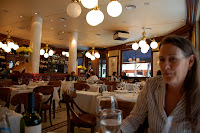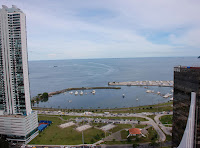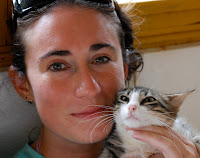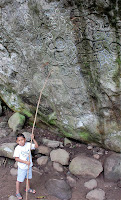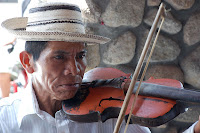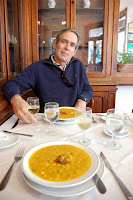 |
| ¡Las chicas en Colombia! |
In mid-April, Linda met up with Belén for 3 weeks of travel through Colombia. From Bucaramanga to San Gil to Barichara in the north central highlands of
Santander, then further north to the Caribbean coast, to Cartagena and Taganga, we traveled up and down and through lots of mountains, some of them verdant, others more like deserts. We traveled via plane, bus, minivan, taxi, boat, and three-wheeled mototaxi (see photo to right), and on foot. We:
- saw all sorts of animals, birds and other flying things, reptiles, fish, and many canine Bounder look-alikes, all of them muy simpáticos;
- communed with nature in various forms, starting at San Gil's gorgeous Parque El Gallineral along the banks of the Rio Fonce (photos here);
- ate lots of good food, including vast helpings of arepas, patacones, and arroz con coco as well as fruits with names for which there is no English translation, various forms of beef, and lots of seafood;
- learned that neither hot water nor a bathroom ceiling are necessary for showering in a warm climate; and
- made the most amazing friends.
Here are some of our tales.
 |
| En route to Barichara |
A few days into our trip, we decided to hike from San Gil to Barichara, appropriately called the "pueblo mas lindo del pais." (More photos of the
forced march here; ) The countryside was gorgeous, changing from one microclimate to another over a distance of about 20 kilometers.
 |
| Cesare & Sonia in their open-air kitchen |
Hours and hours later, we were getting pretty gorgeous ourselves, despite repeated applications of sunscreen.We were still 2 kms outside of Barichara, with plenty of sunshine left, when Belén suggested "autostop." No sooner had we stuck out our thumbs than a Jeep Cherokee screeched to a stop, and we were waved in the back seat. Our saviors were Cesare (originally from Italy) and Sonia (from Colombia), who not only drove us on a quick tour of Barichara but then invited us to the wonderful house they are building right outside the pueblito as a retreat from the urban life in Miami and Bogotá.
(More photos of the house here.) At their kind invitation, we returned the next day as guests for paella, one of Cesare's specialties. Fortunately, Linda had some good wine from Argentina to bring to the feast.
We wound up staying three more nights beyond Cesare and Sonia's departure, exploring Barichara, which is indeed one of the most charming villages we have ever been in.
Photos here. We also took another - mercifully shorter - hike to the nearby pueblo of Guane, "only" 9 kilometers away on the old Camino Real.
Photos here. Linda kept thinking of Werner Herzog's 1972 classic
Aguirre, the Wrath of God.
 |
| Señor, our little-while dog |
While in Barichara, we also met more new friends. Certainly the most cuddly was Señor, our name for a friendly soul who followed us home from the cafe where we had shared our lunch with him on our last full day in Barichara. Alicia, the caretaker of Sonia's house, told us that Señor actually belonged to a nearby family who did not treat him well. We tried to make up for his prior bad experiences with humans. Señor stayed the night with us, guarding our bedroom from any potential intruders, and then went running with Belén the next morning. We tried to convince him to stay with Alicia when our moto-taxi came to deliver us and our luggage to the bus stand, but Señor insisted on accompanying us. He even waited with us til the bus was ready to leave, then kept up with it as long as he could. A good good dog and we were sad to leave him behind.
More photos of him here.
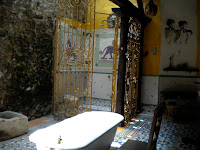 |
Detail of master bath in
Gabriel's house |
Sonia had arranged for our accommodations in Cartagena. While "bed and breakfast" would be the technically correct descriptor for our lodging, the phrase can't begin to convey the atmosphere of Calle de las Palmas 31.
Photos of the house here. For example, the 10 bathrooms in the house we stayed for two nights are artistic installations that also happen to be extremely serviceable. All were designed by our host Gabriel, the uncle of an old school chum of Sonia, who some 20 years ago had begun the long process of rebuilding and combining two colonial mansions in
Getsemaní, one of oldest parts of the city. He had certainly done an exquisite job.
 |
| A fruit lover's paradise |
Despite the brevity of our stay in Cartagena, we managed to see a lot of the old town and, thanks to a mid-afternoon downpour that kept us from leaving, all of the old headquarters of the Inquisition in Cartagena. The museum to those 200+ years there is complete with examples of mechanisms of torture (many of which, such as waterboarding, unfortunately are still in use today in too many places) along with the wording of various spells and incantations. (Linda is considering naming her next dog "Fulano de Tal.")
Photos here. We also had some of the best seafood ever at Donde Socorro, a small restaurant recommended by Gabriel.
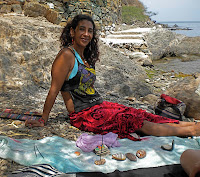 |
| Joanna & her tarot cards |
Next stop: Taganga, a small beach pueblo a few hours via bus east of Cartagena, where the seafood feasts continued and swimming became a top priority for Belén, the quintessential pisces mermaid.
Photos here. We also had the good fortune (and we mean that literally) to meet Joanna, a traveling artisan and seer originally from the north of Chile. Sadly, her mother had been killed by Pinochet's forces when Joanna was an infant; she was raised by her grandmother, a woman well respected for her psychic abilities. On the grandmother's death, Joanna said, birds of all types surrounded the house during the wake. We soon learned first-hand that Joanna has a similar connection with nature at various different levels. That's all we can say. . . .
 |
| Cartagena iguana |

















